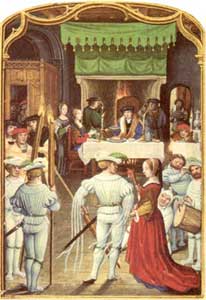| CHRISTMAS AT COURT 
YULE LOGS AND MISTLETOE "Bringing in the Yule log" was a ritual that began in England and that spread throughout Europe, eventually reaching North America. On Christmas Eve, the large central trunk of a great tree was dragged from the forest. Everyone in the family, both adults and children, helped with the job by pulling on the ropes. When the log was finally brought into the house, it was thrown on the family fireplace where it burned for the 12 days of Christmas.
Many superstitions surrounded the log: it had to be ignited the first time a flame was put to it or bad luck would surely follow; it had to be lit with a stick saved from the fire from the year before or the house would burn down; and unless charcoal from the great fire was kept under the family beds for the following year, the house might be struck by lightning. Mistletoe, considered sacred by the British Druids, was believed to have many miraculous powers. Among the Romans, it was symbol of peace, and, it was said that when enemies met under it, they discarded their arms and declared a truce. From this comes our custom of kissing under the mistletoe. England was the first country to use it during the Christmas season. In the early middle ages, it was customary in Europe to hang up a small treetop, upside down as a symbol of the Holy Trinity. This was not only used at Christmas, but was used as a christian symbol of blessing upon the household. In Europe, this evolved into the Christmas Tree as we know it today. In Britain, however, which did not have the custom of cutting tops of fir trees to hang up, there the custom began in the 15th century to create a hoop, or sphere woven from ash, willow or hazel. In the middle was placed a small effigy of the Christ Child or the Holy Family, and the whole hung up inside the threshold of the house. Such items were called Sacramentals and were blessed by the local priest. Anyone who called at the house during the Christmas season showed that they brought only goodwill with them, by a symbolic embrace under this Holy Bough. Over the decades this bough became important also as a status symbol, as families would vie with each other to dress their bough more finely. Ribbons, gilded nuts and small apples were typical. During Cromwell‘s time, the holy figures were removed for fear of breaking the strict Puritanical rules, and facing fines or worse. A bunch of evergreens were hung up in memory of the old Holy Bough, and the memory of an embrace of peace lingered. But two or three generations down the line, such memories became hazy. By the time the Victorians took joy in acknowledging all the old customs again, the custom of the Holy Bough had degenerated into a kiss under the mistletoe. The bough became known as first the Holly Bough, then Kissing Bough.

Backgrounds & page design by ForeverAmber |
 Free Forum Hosting
Free Forum Hosting